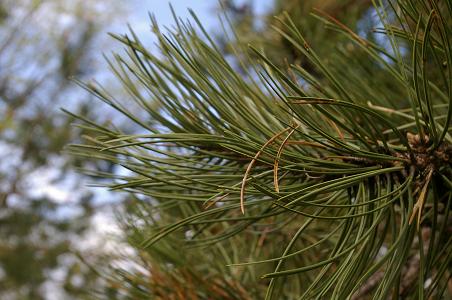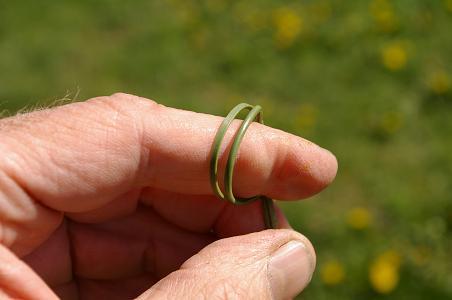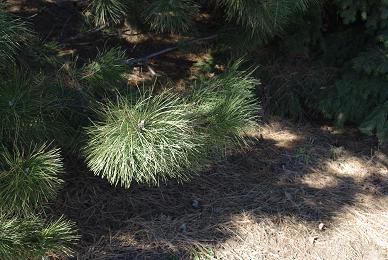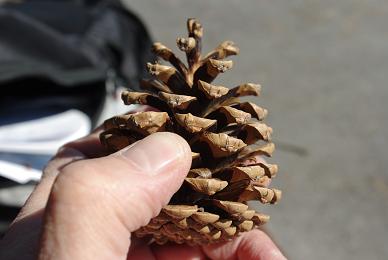GLEBE TREES AND SHRUBS
Austrian pine (Pinus nigra)
Leaves

 May 8 and 15, 2008 on Queen Elizabeth Drive.
Austrian pine has two needles. They are flexible enough to wrap around your fingers (vs red pine).
May 8 and 15, 2008 on Queen Elizabeth Drive.
Austrian pine has two needles. They are flexible enough to wrap around your fingers (vs red pine).
 April 15, 2009.
April 15, 2009.
Cones
 Note the tiny but fairly sharp spine at the chin of the cone,
above my thumb. This differentiates it from the Scotch pine cone.
Note the tiny but fairly sharp spine at the chin of the cone,
above my thumb. This differentiates it from the Scotch pine cone.
Similar species
Scotch pine is the most common similar tree in the Glebe. I distinguish them as follows:
Austrian pine needles are considerably longer. The bunches on a branch are thick, full
and look like a chimney-cleaning brush. The needles on Scotch pine are smaller, sparser,
paler and the bunches are less impressive. Scotch pine needles have a definite twist
to them. I also find that they are harder to tear than Austrian pine, despite the flexibility
of Austrian pine needles.
Scotch pine bark gets markedly orange-coloured in the higher parts of the trunk. Austrian
pine can sometimes have orange elements to the bark, but evenly distributed from the
bottom up.
The cones are very similar but Scotch pine lack the little barb.
Red pine is rare or nonexistent in the Glebe. I have not seen one yet. In practice then, it
is not in the differential.
It usually, but not always, has a ramrod straight trunk, without branches for a long way up.
The bark has a lighter hue, it seems to me. The needles are similar but those of red pine will snap
if wrapped around your finger.
.

 May 8 and 15, 2008 on Queen Elizabeth Drive.
Austrian pine has two needles. They are flexible enough to wrap around your fingers (vs red pine).
May 8 and 15, 2008 on Queen Elizabeth Drive.
Austrian pine has two needles. They are flexible enough to wrap around your fingers (vs red pine).
 April 15, 2009.
April 15, 2009.
 Note the tiny but fairly sharp spine at the chin of the cone,
above my thumb. This differentiates it from the Scotch pine cone.
Note the tiny but fairly sharp spine at the chin of the cone,
above my thumb. This differentiates it from the Scotch pine cone.